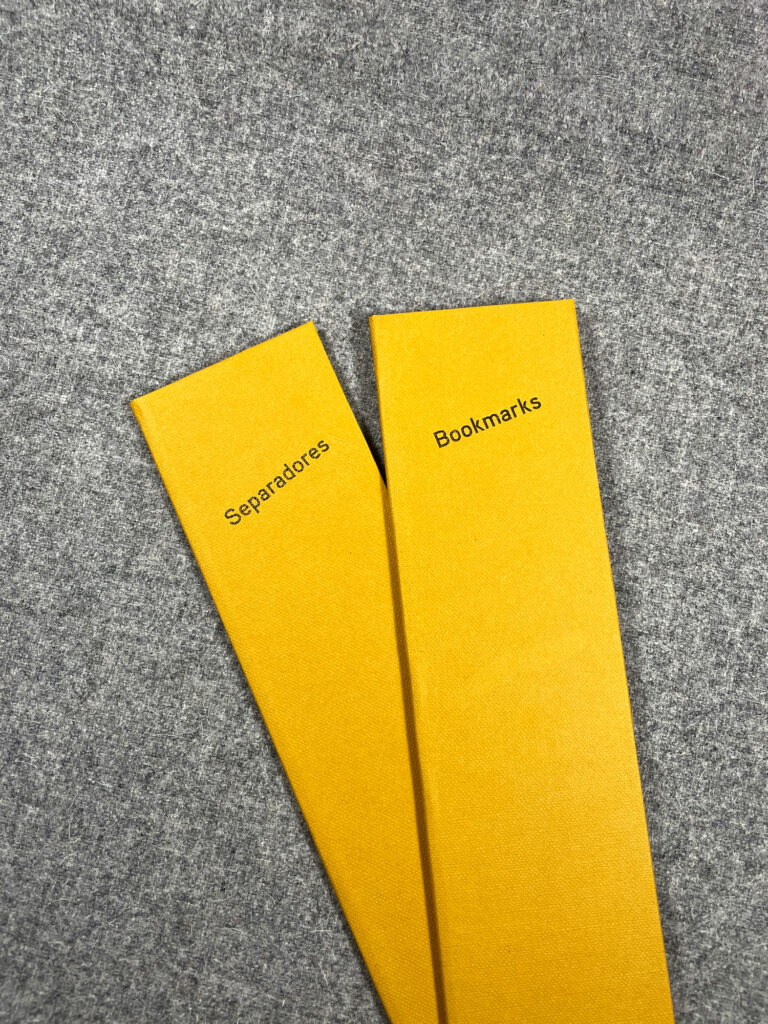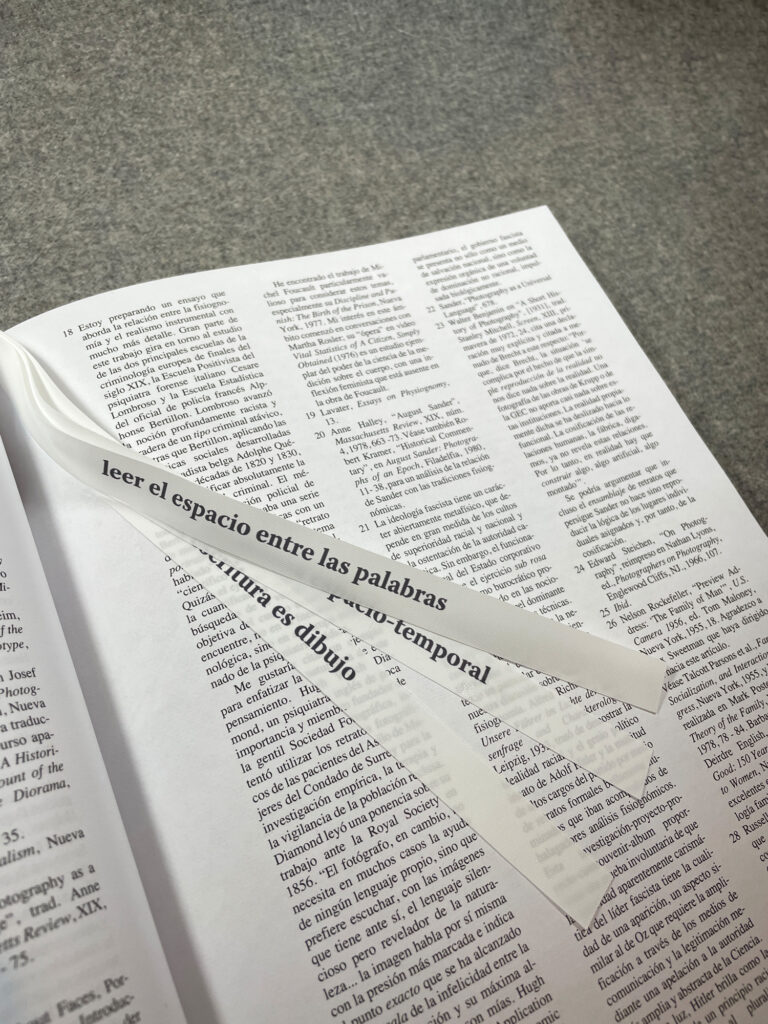Separadores/Bookmarks (2022) by Alfonso Santiago pushes the boundaries of what a book is and what it can be, by performing multiple functions as a book, a bookmark, and a conceptual parasite. Two versions of the book exist, in Spanish and in English, published through Santiago’s Mexico City-based press, Piedra Ediciones. The book takes the form of a narrow hardcover casing, which opens into a set of eight or so (the number is not consistent in each book) fabric bookmarks that are rough in texture. The set is sewn together and held inside the boarded cover with double-sided tape. Though barely adhering to the codex form with its very short-end sewn binding, Separadores/Bookmarks can nevertheless be read as a book typically would, sequentially from page to page. Each bookmark, which serves as an individual page, contains one line that questions the limitations of language and the written form: “All writing is drawing.” “Break free from the constraints of language.” “Find ways to make space.” And yet, despite its brevity, Separadores/Bookmarks is not a book that readers are able to flip through quickly. The act of turning each of the long, thin, drooping bookmarks requires a careful pace, and thus, a slow reading.

Alfonso Santiago
Self-published by Piedra Ediciones, 2022
10.6 x 2.4 in. (27 x 6 cm) (cover, closed)
Variable number of fabric bookmarks Edition of 100
Ribbons bound with a headband and affixed into a hard case
Digital printing on fabric
CBA Collection no. FA.B126.2550
Separadores/Bookmarks is fragile, but not precious. Through both its form and title, the work suggests that its primary purpose is to perform the entirely practical function of holding one’s place in a book, as a bookmark. The double-sided tape securing the set of bookmarks is precarious at best, begging the reader to pull them out of the hardcover shell and utilize them in other books. The impermanency of the tape’s adhesive further suggests that once removed, the bookmarks will no longer be able to be put back into its original casing. The act of removing the bookmarks, then, feels like an irreversible decision—one that activates another function and another reading. By inserting them in between the pages of another book, Separadores/Bookmarks is compressed and flattened, becoming largely inaccessible. Statements such as “A book is a space-time sequence” and “Nowhere better than this place” can stay unread, possibly forgotten or ignored, as a book within a book. In order to reactivate its former function as a book, the reader must first open the book that Separadores/Bookmarks is holding the pages for.

Santiago describes Separadores/Bookmarks as a piece that needs “to parasitize a book in order to exist and be read.”[1] The work is in dialogue with the artist’s collaborative publication Conversar en forma de libro 02 (2020–2021), which was produced during a workshop, “where each one of the participants created an object to be forgotten inside a book in the process of reading.”[2] Objects such as a restaurant order form, a library checkout card, and a bookplate all serve to shift the reading experience of their host books. Parasites live on or in their host, and as a conceptual parasite, Separadores/Bookmarks relies on its host book for its fullest meaning-making potential. While parasites often hold negative connotations, they can also be part of symbiotic relationships. Within Santiago’s framework, the bookmarks are meant to be read alongside the book in which they are placed. Pages such as “Words that exceed language” and “Read the space between words” and “Somewhere better than this place” are no longer solely interpreted on their own, but instead, disrupt, interrupt, add to, or are infused with the text and images of their host book. The simple and familiar act of holding a page with a bookmark becomes an act of adding a page, possibly changing the way that book is read. Similar to randomly generated lines in computational literature, the results of words next to the page are sometimes nonsensical, and sometimes powerful; whether or not the bookmarks succeed in creating new meaning is totally dependent on the reader. Santiago is calling attention to the way that meaning is made, with Separadores/Bookmarks as an experiment.

Santiago challenges readers to seek out the new books we are creating. While a book might reveal its author, a bookmark might reveal its reader. Housed inside a book, bookmarks can often inform a passerby of its past readers, giving clues through personalized notes and hallmarks that indicate a place or time. The postcards, flyers, movie stubs, or receipts that are often casually thrown between the pages of a book can offer insight into a reader’s culture, travels, or environment. Through this work, Santiago raises further questions about authorship within the act of reading—that anytime we read, we bring with us lingering thoughts, emotions, and memories that can infect what we are reading. The meditative statements that Separadores/Bookmarks offers on each of its pages pull the reader out of the book with prompts to conceptualize spaces beyond the page and beyond language. Separadores/Bookmarks is a simple yet effective conceptual exercise in generating new meanings by playing with the familiar notions of a bookmark and a book. Most bookmarks or objects inserted inside of books are likely to be ignored or go unread. Whether a reader keeps Separadores/Bookmarks in its original casing, removes it for its practical function as a bookmark, or tests out its conceptual merits to generate new meaning is up to them. Separadores/Bookmarks invites the reader to discover and explore.

- (1)
Email to author, July 26, 2022.
- (2)
Email description to author, July 26, 2022.

Alfonso Santiago
Self-published by Piedra Ediciones, 2022
10.6 x 2.4 in. (27 x 6 cm) (cover, closed)
Variable number of fabric bookmarks Edition of 100
Ribbons bound with a headband and affixed into a hard case
Digital printing on fabric
CBA Collection no. FA.B126.2550


